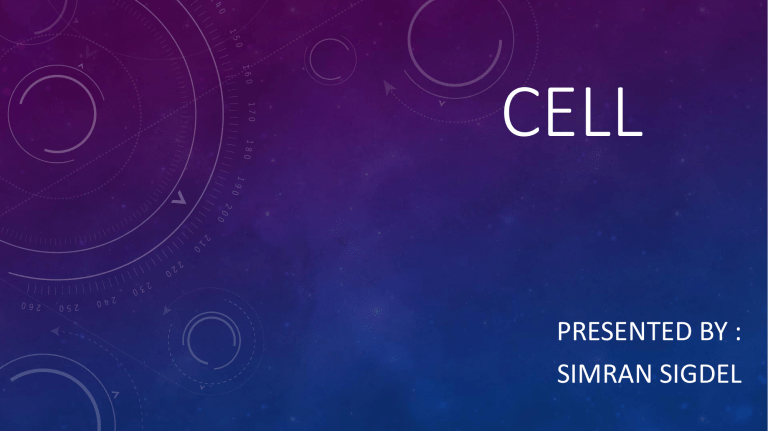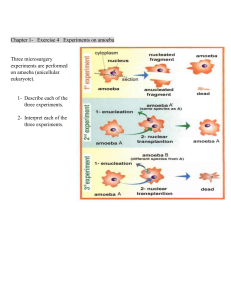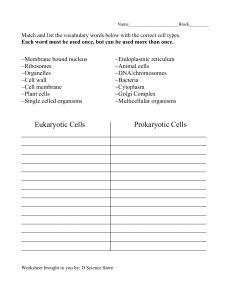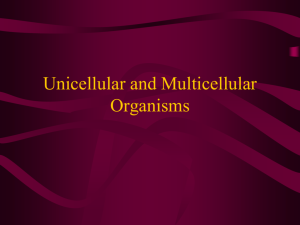
CELL PRESENTED BY : SIMRAN SIGDEL CONTENTS • Introduction • Discovery of cell • Types of cell • Shape, size, and structure • Structure of a cell • Functions of different cell organelles • Plant cell and animal cell (typical cell) • Amoeba And Hydra WHAT IS CELL ? Cell is the basic unit of life and that is responsible for the shape and structure of a living body . As a building is made up of bricks , a living body is made up of cells . The work done by a living body is the total work done by all the cells . So , a cell is the structural and functional unit of life . DISCOVERY OF CELL The word ‘cell’ is derived from the Latin word ‘cellula’ which means ‘a little room’. The discovery of cells dates back to 1664 when British botanist Robert Hooke gave the name cell .to the honeycomb-like structure observed in a slice of bottle cork under his crude microscope. In 1840,J.R. Purkenje used the term protoplasm to describe the juicy , slimy content of the cell . The protoplasm was referred as the physical basis of life. Thus, it was clear that all organisms from unicellular to multicellular organisms are made up of cells and every cell has protoplasm to conduct life activities like growth , movement , sensitivity , respiration and reproduction. TYPES OF CELL a) Prokaryotic Cell The cells with primitive or poorly developed nucleus are called prokaryotic cells. In such cells, the nuclear membrane is absent and the nuclear materials is in direct contact with the cytoplasm. DNA is absent in the nuclear material. Such cells are found in organisms like bacteria and blue green algae. b) Eukaryotic Cell These are the true cells with nucleus bounded in a nuclear membrane. DNA is present in the nuclear material. All higher organisms have eukaryotic cells The cells with a definite and functional nucleus are called eukaryotic cell. SHAPE , SIZE AND STRUCTURE The structure and shape of cells differ from species to species and organ to organ of living organisms. Even a plant cell differs from an animal cell. The shapes of the cells differ according to the function they have to perform. Unicellular organisms like amoeba and white blood cells (WBC) constantly change their shape whereas nerve cells , red blood cells (RBC) and plant cells have fixed shape. Cells are too small to be seen through our naked eyes. Except some big cells like eggs of birds, other cells are microscopic. The size of a cell ranges from 0.1 to 1 (micron). The smallest cell of a human being is the red blood cell. The longest cell is the nerve cell ,which may be up to 3.5 feet in length . A cell may be irregular (Amoeba, WBC),flat (skin cells),spindle shaped (muscle fibers ), spherical (RBC) or cubical in shape . STRUCTURE OF A CELL A cell has many smaller living cytoplasmic units suspended in the ground liquid –protoplasm. Such parts of a cell are called the cell organelles. Besides, some non- living substances like waste materials, oil droplets, collectively called cell inclusions, are also present in the cytoplasm. Some of the cell organelles are as follows : 1. Cell wall / cell membrane 2. Cytoplasm / protoplasm 3. Mitochondria 4. Nucleus 5. Plastids 6. Endoplasmic reticulum 7. Ribosome 8. Golgi bodies 9. Lysosome 10. Centrosome / centriole FUNCTIONS OF CELL ORGANELLES 1) Mitochondria : it is the powerhouse of cell as it releases and stores energy in form of ATP. 2) Nucleus : it is the controlling sector of the cell. 3) Endoplasmic reticulum : it transports various substances within the cell . 4) Ribosome : it provides a space for protein synthesis. 5) Lysosome : they are secret enzymes (digestive juices). 6) Golgi bodies : They are responsible for secretion, synthesis and storage of various organic compounds. 7) Centrosomes : they helps in cell division by forming spindle fibers. 8) Plastids : They help in coloring different parts of a plant PLANT CELL AND ANIMAL CELL Plant cell They are larger and rectangular in shape. cellulose cell wall is present. Plastids are present. Vacuoles are usually large and centrally placed. Centrosome is absent. Golgi bodies are scattered in the cytoplasm and are called dictyosomes. Animal cell They are smaller and oval in shape. Cellulose cell wall is absent. Plastids are absent. Vacuoles are usually absent. If present they are small and temporary. Centrosome is present. Golgi bodies are well developed and are near the nucleus. AMOEBA Amoeba is a unicellular protozoan animal . Amoeba is one of the disease causing organisms. It is found in water or watery medium. Many children get sick due to amoeba (Entamoeba histolytica). HYDRA It is 2- layered metazoan. It has two layers in the body with a cavity and is known As coelenterate. Hydra is fresh water living animal. It is multicellular animal attached on the surface or leaves of aquatic plants . It is available where oxygen and light is available. Thanks for watching






